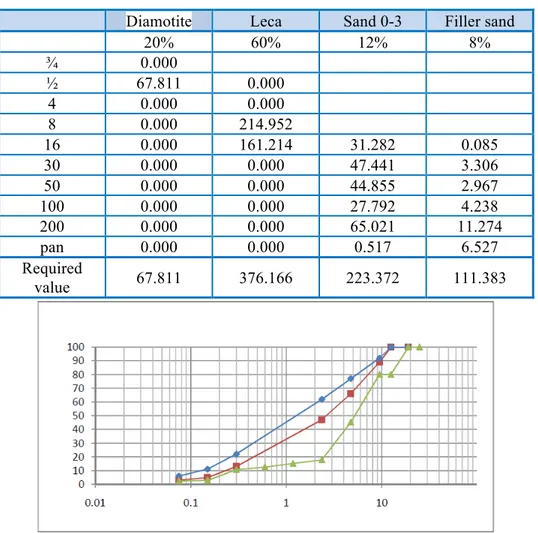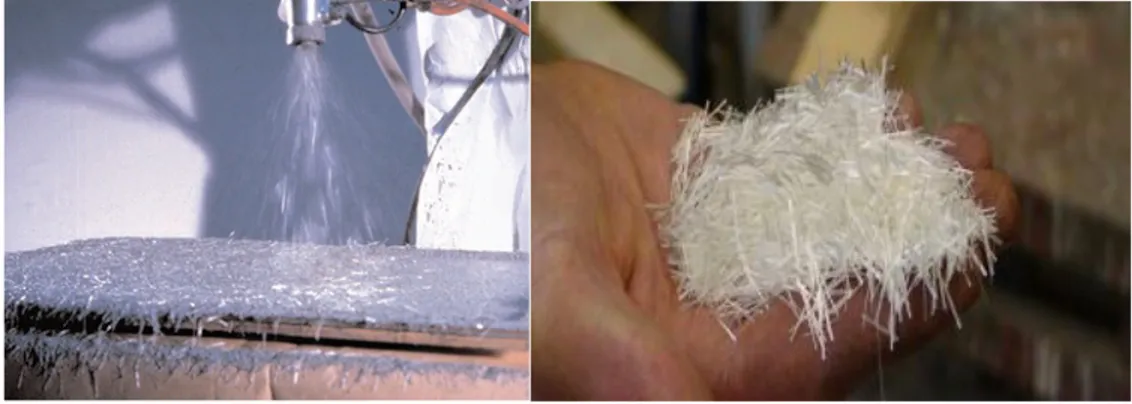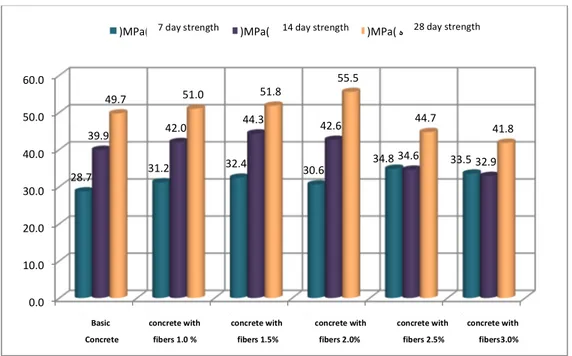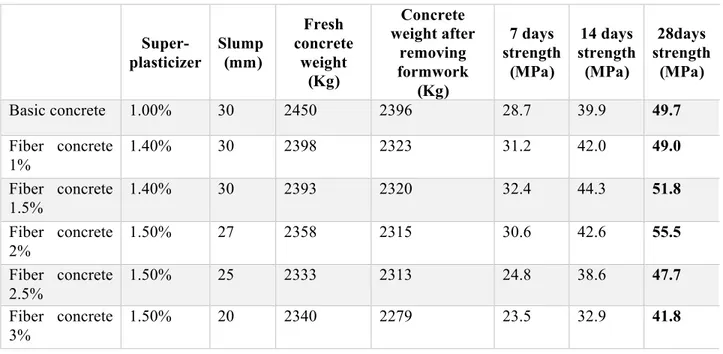EXPERIMENTAL SURVEY OF THE EFFECT OF USING DIAMOTITE
LIGHTWEIGHT AGGREGATE AND PVC-COATED GLASS FIBER ON
STRUCTURAL LIGHTWEIGHT CONCRETE
Alireza Shabanian Tafti
Department of Civil Engineering, Lenjan branch, Islamic Azad University, Isfahan, Iran
ABSTRACT
Based on the increasing growth of concrete construction in the current development world, much progress in different scientific fields of concrete industry is occurred and production of structural lightweight concrete is the result of such progress. These concretes are constructed using lightweight and strong aggregates. Using different lightweight aggregates to reduce the weight of structural elements and finally structural light weight against earthquake has been development recently. This study applied ultra- lightweight diamotite. This lightweight aggregate has volume weight of 260 kg/m3 and from weight aspects, it is the lightest lightweight aggregate in the market. In recent years, using different fibers as construction material reinforcement in concrete industry has received much attention. In this study, spiral glass fiber with PVC coating and mesh texture are used. The Researches showed that glass fiber was harmless due to having a PVC coating. This study has experimental evaluation of the effect of using diamotite lightweight aggregate and glass fibers with PVC coating on structural lightweight concrete. To do this, some experiments are performed on all mixtures of lightweight concrete including water absorption test, compressive strength and unit weight on selected mixture design. Based on the results of mentioned constructed samples, the mentioned lightweight concrete had acceptable results despite the low unit weight compared to the similar samples in the presence of diamotite lightweight aggregate and fibers.
Keywords: Lightweight concrete, Leca, Diamotite, PVC-coated Glass fiber
INTRODUCTION
In current world and based on the progresses in different scientific fields, concrete industry has been changed and production of lightweight concretes is the result of such progress. This concrete besides the reduction of dead load of building reduces the force imposed on structure in case of earthquake and in case of destruction, the weight of debris is also reduced and it is called the concrete of the century. One of the construction methods with its great development is concrete buildings. After Islamic Revolution of Iran, due to the shortage of beam due to sanctions and development of civil constructions in the country, the concrete applecation was increased considerably. In addition, concrete buildings have many advantages including high resistance to fire, noise and corrosion, easy construction of concrete due to the abundance of concrete materials compared to steel buildings. The structural lightweight concretes have density less than 2000 kg/m3 and compressive strength more than 17MP. These concretes are made only using lightweight and strong aggregates. All structural lightweight concretes belong to lightweight aggregate concretes in which lightweight aggregates are used to reduce unit weight.
Thus, the terms lightweight concrete and structural lightweight concrete are used to define a concept. In structural lightweight concretes, the aggregates are used in which the concrete has strength more than 17MP and unit weight less than 2000 kg/m3. The aggregates meeting these conditions in accordance to
a. expanded Shale, Clary and slate in rotational furnace b. The aggregates being made by agglomeration processes. c. Expanded slag
d. Natural lightweight aggregate e. Synthetic lightweight aggregate f. Deposited fly ash
Providing compressive strength equal to 20N/m2 or more with some of these aggregates is possible. The condition of other aggregates is as minimum compressive strength for structural lightweight concrete is achieved. The strength of lightweight concrete is dependent upon its unit weight. It should be considered that unit weight is mostly affected by unit weight of aggregates as lightweight materials can reduce unit weight of concrete but using heavier materials than lightweights cannot increase the constructed concrete strength (Maghsudi, 2007). (Wang, 1989). There are different types of fibers improving the concrete properties. Indeed, concrete has not complete mechanical properties alone. Recently, various studies have been conducted to achieve poly propylene fiber properties. Also, some studies have been conducted between the properties of carbon fiber and poly propylene fiber (Kakemi , 1996) glass fiber and poly propylene fiber (Wang, 2006) or carbon fiber and glass fiber (Peres, 1994)( Mobasher, 1996). Although these studies include the comparison of the poly propylene fiber with other fibers, most students focus on steel poly propylene fiber (Hua, 2005), (Abbas, 2002). Steel fibers have high elasticity and stiffness and increase compressive strength and concrete toughness. On the other hand, poly propylene fibers have good ductility and dispersion so they can restrain plastic cracks. Also, good combination of both types of fibers can improve mechanical properties of concrete. Adding steel fibers to concrete can improve concrete properties but the fiber content must be high. It increases structure weight of concrete and has balling effect during mixing so that workability will be decreased. In addition, steel fibers easily basset and rust and it also has the problem of magnetic field. If steel fiber-reinforced concrete is used in the runway of airport and nuclear power plan, it many have the safety problem (Song, 2005). The main reason of innovation of fiber is elimination of rebar of structures for severe corrosion of rebar in humid areas namely underground structures and relative rigidity of reinforced concrete against earthquake and various vibrations and it is considered mostly in underground arteries. The investigation of this phenomenon has received much attention from Japan (high seismic) and US and now the production technology of this fiber is dedicated exclusively to these two countries. Based on the investigations on this type of concrete, improvement of the following properties compared to ordinary concrete is expected: - High energy absorption and good ductility
- Increase of rupture strength after the first crack - Reduction of crack in concrete with high ductility - Increase of tensile strength
- Reduction of concrete loss
EXPERIMENT
To achieve concrete with required performance, the first step is selection and recognition of materials components. The next step is a trend called determination of mixture ratio by which correct combination of concrete elements is achieved. Determine mixture ratios is a complex process and this is based on the fact that required properties of concrete can be affected by the change of a definite variable. For example, adding water to an unworkable concrete mixture with definite cement improves the fresh concrete fluidity but its strength is reduced. Indeed, workability is composed of two main components: Fluidity (flowing easily) and adhesion (resistance against separation). These two components interact when water is added to concrete admixture. Thus, mixture design balances the opposite porous effects as it was said. There are various methods to compute the concrete mixture ratios around the world but two methods of weight method and absolute volume are much common. Weight method is less precise but it doesn’t need some information about the density of concrete construction materials. The absolute volume method has high precision. By second method (absolute volume), mixture design is computed. Thus, unit weight of all materials is achieved. The mixture design includes the following items:
1- Adhesive includes pozzolan and cement. In this study microsileca pozzolan, metakaolin and zeolite.
2- Aggregate materials include Leca (with particle size and without particle size), gravel, sand and mineral aggregate (Pumice) and diamotite lightweight aggregate.
To construct this lightweight aggregate(Diamotite), clary as raw material is reduced and a new material called diamotite made of glass recycling materials is added in combination with clary. In this process, some pores are created inside the lightweight aggregates and this makes acoustic feature of the lightweight aggregate and thermal conductivity is reduced. These aggregates are economical. They are made similar to synthetic lightweight aggregates including Leca and its construction cost is equal to the cost of Leca construction. There is only one difference is noise and heat proof and its unit weight compared to Leca lightweight aggregate is exactly half, 240 kg/m3. Unit weight of diamotite aggregates is 210 to 310 kg/m3. The unit weight of constructed concrete with these aggregates at compact state is 750 kg/m3 and at non-compact case is 450 kg/m3. The low weight of aggregate is due to empty space inside the aggregates and based on sizing occupies 73-88% of total space.
Figure 1- Diamotite lightweight aggregate Table 1- Particle sizing of applied diamotite
Diamotite Leca Sand 0-3 Filler sand
20% 60% 12% 8% ¾ 0.000 ½ 67.811 0.000 4 0.000 0.000 8 0.000 214.952 16 0.000 161.214 31.282 0.085 30 0.000 0.000 47.441 3.306 50 0.000 0.000 44.855 2.967 100 0.000 0.000 27.792 4.238 200 0.000 0.000 65.021 11.274 pan 0.000 0.000 0.517 6.527 Required value 67.811 376.166 223.372 111.383
Figure 2- Particle sizing chart of applied aggregate in mixture design
GLASS FIBER
Glass fiber was applied with cement and was called Glass reinforced concrete (GRC). Adding glass fiber to concrete affects the reduction of fresh concrete workability (Banthia , 2003), (Chen , 2005). Thus, good plasticizers should be used and good mixture method should be also experienced. Also, glass fiber adheres in fresh concrete and this leads to balling of fibers. In this case, fibers distribution is not uniform anymore and a solution should be found to eliminate it.
Figure 3- Glass fiber
The advantages of using this type of fiber include: - Flexural stiffness equal to steel
- Long life of structure- no corrosion of concrete - Light weight compared to steel fibers
- Reduction of damages of fire
- Reduction of wear-out and abrasion in concret pump and concrete pipes compared to steel fibers The applied cement in the experiment is portland cement type II of Isfahan cement factory as 450kg/m3 in the mixture. The potable water withotu any chemical contamination was used. The water added to the mixture was 160kg/m3 and water-cement ratio was 0.356. To reduce water in concrete due to using fiber, a new material Adva flow 501 with Grace brand was used to reduce water in concrete construction. This maerial is liquid based on poly carboxy material as 1.6 to 2.1 weight percent of cement.
To construct concrete, baching of University Lab with capacity 50Lit is used. The mixture is as at first aggregates (lighweight aggregate and sand) and cement are poured dry into the system and after mixture for 1 min, 0.75 of water is added gradually. Then, the fibers are added gradually and later Grace plasticizers and Air Entraining agents are added. After this phase, the rest of water is added to the admixture and is mixed for 3 min in batching and is prepared to be placed in the forms.
The general mixture design and admixture design based on Batching capacity are shown in the following Tables.
Table 2- The general mixture design of fivers lightweight concrete construction
Super plasticizer Fibers Lightweight aggregate (5-12mm) Sand (0-5mm) water Cement 1.6-2.1 % 1-3 % 835 kg/m3 837 kg/m3 160 kg/m3 450 kg/m3
Figure 4- The compressive and tensile samples and curing method
EXPERIMENTS AND RESULTS
THE EVALUATION OF THE EFFECT OF USING FIBERS
To determine the optimal percent of fibers, compressive strength test on cubic samples 100 x100 x100 mm is used and the results are shown in Table 3. Based on the results of compressive strength charts and experiments at the day 3, 7, 14, 28 days, we can say the best percent of using studied fibers to start strength tests based on 5% proposed value is 2% as weight alterative of cement.
Figure 5- The compressive strength chart of different percent of fibers
After achieving optimal percent of fibers in mixture design, we investigate the mechanical properties of lightweight concrete with and without fiber.
0.0 10.0 20.0 30.0 40.0 50.0 60.0 هیاپ نتب اب نتب %1 فایلا %5.1 فایلا اب نتب %2 فایلا اب نتب %5.2 فایلا اب نتب %3 فایلا اب نتب 28.7 31.2 32.4 30.6 34.8 33.5 39.9 42.0 44.3 42.6 34.6 32.9 49.7 51.0 51.8 55.5 44.7 41.8 )MPa( هزور 7 تمواقم7 day strength )MPa( هزور 14 تمواقم14 day strength )MPa( هزور 28 تمواقم28 day strength
Basic concrete with concrete with concrete with concrete with concrete with
Concrete fibers 1.0 % fibers 1.5% fibers 2.0% fibers 2.5% fibers3.0%
Table 3-Compressive strength with optimal fiber percent 28days strength ) MPa ( 14 days strength ) MPa ( 7 days strength ) MPa ( Concrete weight after removing formwork ) Kg ( Fresh concrete weight ) Kg ( Slump ) mm ( Super-plasticizer 49.7 39.9 28.7 2396 2450 30 1.00% Basic concrete 49.0 42.0 31.2 2323 2398 30 1.40% Fiber concrete 1% 51.8 44.3 32.4 2320 2393 30 1.40% Fiber concrete 1.5% 55.5 42.6 30.6 2315 2358 27 1.50% Fiber concrete 2% 47.7 38.6 24.8 2313 2333 25 1.50% Fiber concrete 2.5% 41.8 32.9 23.5 2279 2340 20 1.50% Fiber concrete 3%
ABSORPTION OF WATER OF SAMPLES
Based on the effect of concrete water absorption on mechanical properties of lightweight concretes namely in facing invasive fluid environments including acid and alkaline environments, it is decide to investigate this parameter before the start of main tests. To do this, cubic samples 100 x100 x 100 mm are made for control concrete, diamotite and other lightweight aggregates in experiments to evaluate the long-term water absorption. All the samples were kept for 48 hours in ovens at temperature 105℃ at 28 days after curing period. Then, they were weighted and kept in water pond. Water of all specimen was absorbed at days 1, 2, 7, 14, 28 after being removed of the pond and drying. The results of measuring water absorption are shown in Table 4.
Based on the results in this Table and Chart 6, we can say the specimen with pumice lightweight aggregate have the lowest water absorption compared to other samples. This is due to water absorption of lightweight aggregates including pumice and Leca. The reason of reduction of water absorption of concrete with pumice compared to other lightweight aggregates is due to high density of this lightweight aggregate and its high density compared to other lightweight aggregates including diamotite.
This is also true about the specimen with Leca and diamotite, with the difference that high tendency of lightweight aggregate to water absorption causes that its porosity to increase long-term water absorption is adequate and it has high absorption compared to other light weight concretes and by increasing fibers, water absorption is also increased.
Table 4- The results of samples of water absorption tests of type of applied lightweight aggregate Percent of water absorption of specimen compared to control sample Water absorption 28 days Water absorption 14 days Water absorption 7 days Water absorption 2 days Water absorption 1 day Weight of fresh concrete ) Kg ( Water absorption to the complete dry specimen -5.30% 5.20% 5.20% 4.90% 4.90% 2450 Ordinary concrete 7.55% 5.70% 5.60% 5.50% 5.10% 4.90% 1980 Concrete with pumice lightweight aggregate (mineral lightweight aggregate) 15.09% 6.10% 6.00% 5.90% 5.40% 5.10% 1737 Leca lightweight concrete 52.83% 8.10% 8.00% 7.90% 7.60% 7.50% 1390 Concrete with diamotite lightweight aggregate 54.72% 8.20% 8.20% 8.20% 7.80% 7.70% 1365 Concrete with diamotite lightweight aggregate and 2% fiber 2.00% 3.00% 4.00% 5.00% 6.00% 7.00% 8.00% 9.00% 0 7 14 21 28 ک ش خ ال ما ک نت ب ه ب ت ب س ن ب آ ب ذج نا زی م )زور( بآ بذج یریگ هزادنا نس دهاش تنب سیموپ هنادکبس اب تنب اکیل هنادکبس تنب تیتوماید هنادکبس اب تنب فایلا % 2 و تیتوماید هنادکبس اب تنب Wa te r a bs or pt io n t o t ot ally d ry co nc re te Concrete with Pumice lightweight aggregate diamotite lightweight aggregate Control concrete Lightweight concrete of Leca Concrete with diamotite lightweight aggregate and 2% fiber Water absorption measurement age (Day)
Figure 6- The long-term water absorption of studied concrete specimen Table 5- The results of short-term water absorption
24 hours One hour Half hour Particle size ) mm ( 15.4 11.5 10.4 4 Diamotite lightweight aggregate 15.5 11.6 10.8 5.6 15.6 11.6 11.1 6.3 15.7 11.9 11.1 8 11.3 7.0 6.7 4 Leca 5.6 6.6 6.8 11.1 10.9 6.0 6.6 6.3 10.8 6.7 6.3 8 6.7 5.3 5.2 4 Pumice 5.6 5.4 5.4 6.8 6.8 5.5 5.4 6.3 6.9 5.7 5.6 8
COMPRESSIVE STRENGTH TEST
Here, we evaluate the compressive strength of constructed specimen with fibers with code I and without fiber with code II with different lightweight aggreate combination. The specimen are coded as D for diamotite concrete, L for Leca and P for Pumice. To determine compressive strength of cubic specimen, the test is performed on some specimen 100 x100 x 100 mm and the results of test are shown in Table 6.
Figure 7- The system of testing compressive strength and cubic concrete specimen Table 6- Compressive strength of lightweight concrete specimen with or without fibers
Compressive strength turned to 75 x150 MPa
Compressive strength MPa
Specimen age (day) Code 10.71 13.91 7 F/D/I/7 19.83 25.75 28 F/D/I/28
14.91 19.37 7 F/D/II/7 23.00 29.88 28 F/D/II/28 26.62 34.57 91 F/D/II/91 9.98 12.96 7 F/L/I/7 19.17 24.90 28 F/L/I/28 22.21 28.85 91 F/L/I/91 15.63 20.30 7 F/L/II/7 25.23 32.77 28 F/L/II/28 30.68 39.85 91 F/L/II/91 13.40 17.40 7 F/P/I/7 22.77 29.58 28 F/P/I/28 30.25 39.28 91 F/P/I/91 16.40 21.30 7 F/P/II/7 26.57 34.50 28 F/P/II/28 33.55 43.57 91 F/P/II/91
Figure 8- The results of compressive strength and cubic concrete specimen BRAZILIAN TENSILE TEST
Brazillian tensile test is performed on cylinder specimen with size 150 x300 mm in accordance to standard ASTM C 496 (standard test of computation of Brazillian tensile strength of concrete cylinder specimen) and the results are shown in Table 7.
0.00 10.00 20.00 30.00 40.00 50.00 7 28 91
MP
a
specimen code
Compressive strength of lightweight concrete without fiberF/D/I F/L/I F/P/I
0.00 10.00 20.00 30.00 40.00 7 28 91
MP
a
specimen code
Compressive strength of lightweight concrete with fibersF/D/II F/L/II F/P/II
Figure 9- The device of doing Brazilian tensile test and specimen fracture and removing fibers from
concrete
CONCLUSION
This study had an experiment survey of the impact of using Diamotite lightweight aggregate and PVC coated glass fiber on structural lightweight concrete. To do this, some tests have been conducted on all admixture designs of lightweight concrete including water absorption, compressive strength, tensile test and unit weight on selected admixture designs and finally the following results were achieved:
1- The comparison of the results of compressive strength shows that compressive strengths of constructed samples from different lightweight aggregates without glass fiber with PVC showed high resistance compared to the specimen with fibers. This rule is true at all ages. This is due to the entrapped air and concrete compaction problems.
2- The best percent of using the studied fibers as 2% as weight alternative of cement.
3- The results show that using unit weight fibers reduce the volume of fresh concrete and this is due to the low unit weight of fibers compared to cement.
4- The specimen with Pumice lightweight have the lowest water absorption compared to other specimen. This is due to the absorption of water of lightweight aggregates including pumice and Leca. The reason of reduction of water absorption of concrete with pumice compared to other lightweight aggregates is due to high density of this lightweight aggregate and its high density compared to other lightweight aggregates including diamotite.
5- Using PVC –coated fiber glass increases tensile strength of lightweight concrete specimen about 15%. Thus, using PVC-coated glass fiber improves tensile strength of lightweight concrete but it has no positive effect on the results of water absorption and compressive strength tests.
6- Diamotite lightweight specimen with lower unit weight compared to the specimen with other lightweight aggregates show acceptable results in all tests including water absorption, compressive and tensile strength. Thus, using diamotite lightweight is recommended in construction of structural lightweight concretes based on the results.
Table 7- Tensile strength of specimen regarding the tests of type of applied cement
Tensile strength
MPa
Specimen age (Day) Code
REFERENCES
Rahmat Madandust, Malekmohammad Ranjbar, Iman Mohammadpour Nikbin. 2013. The evaluation of the mechanical properties of lightweight concrete. The tenth national congress of civil engineering. Babolsar University.
Maghsudi, Ali Akbar; Mohammadpour, Shahram. Design, construction and evaluation of mechanical properties of self-compacting mechanical properties with or without Nano. The third national congress of civil engineering. Tabriz University. 2007.
K.S. Wang, I.J. Chiou, C.H. Chen, and D. Wang, Lightweight properties and pore structure of foamed material made from sewage sludge ash, Constr. Build. Mater, 19(2005), No. 8, p. 627Ozawa, K., “Development of high performance concrete based on the durability design of concrete structures”, EASEC-2, Vol. 1, pp.445-450, 1989.
M. Kakemi, D. Hannant, Cem. Concr. Compos. 18 (1) (1996) 61–66. W.Wang, S.Wu, H. Dai, Mater. Sci. Eng. A 434 (1) (2006) 347–351. B. Mobasher, C.Y. Li, ACI Mater. J. 93 (3) (1996) 284–292.
M. Perez-Pena, B. Mobasher, Cem. Concr. Res. 24 (6) (1994) 1121–1132.
Y. Hua, J.Y. Lian, T.Q. Zhou, Jianzhu Cailiao Xuebao/J. Build. Mater. 8 (1) (2005) 71–76. R. Abbas, E. El-Rafey, A. El-Shiekh, A. Kamel, Alex. Eng. J. 41 (3) (2002) 455–464. P.S. Song, S. Hwang, B.C. Sheu, Cem. Concr. Res. 35 (8) (2005) 1546–1550.
N. Banthia, N. Nandakumar, Cem. Concr. Compos. 25 (1) (2003) 3–9. B. Chen, J. Liu, Cem. Concr. Res. 35 (5) (2005) 913–917.
ASTM C 157, Standard test method for length change hardened hydraulic cement mortar and concrete, Annual Book ASTM Standards, 4 (04.02), 2002.
ACI Committee 544, State of the art report of fiber-reinforced concrete, Concr. Int.: Des. Construct. 4 (5) (1982) 9–30. 6.39 28 F/D/ II /28 9.22 91 F/D/ II /91 5.83 7 F/D/I/7 7.75 28 F/D/I/28 10.15 91 F/D/I/91 3.57 7 F/L/ II /7 6.66 28 F/L/ II /28 9.33 91 F/L/ II /91 6.39 7 F/L/I/7 8.43 28 F/L/I/28 10.98 91 F/L/I/91 3.02 7 F/P/ II /7 5.45 28 F/P/ II /28 6.98 91 F/P/ II /91 4.68 7 F/P/I/7 6.70 28 F/P/I/28 7.52 91 F/P/I/91







